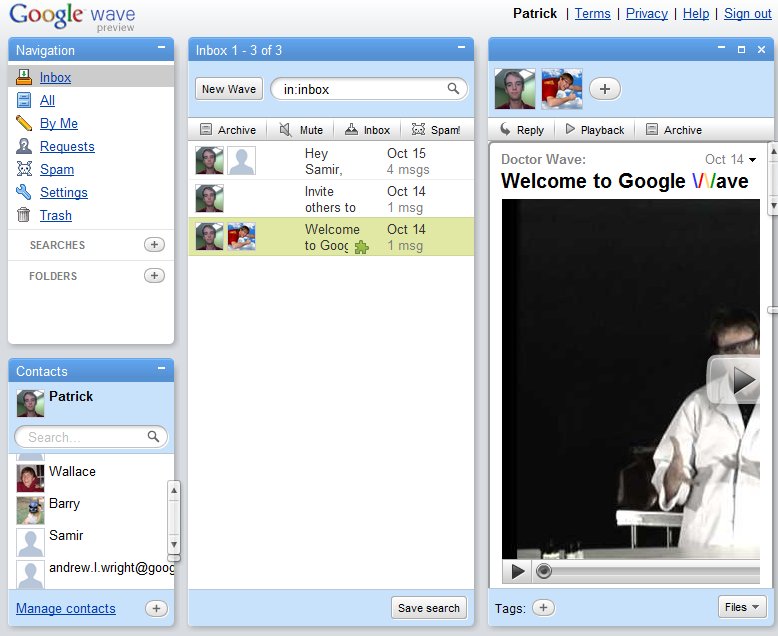Instead blogging about Europe and it’s intricacies and wonderments, I thought I would shift gears on this post. As a CIS student, I would like to implore you to try out Google Wave, a new and intriguing communication technology from one of the most innovative companies in the world.
For anybody that does not know, Google Wave was announced in late May at the Google I/O conference. You can watch the 80 minute video where they introduced the technology here. Or for those without an outrageous amount of time and interest, you can just watch the first 2 minutes, and say you saw the whole thing. The video is quite a la Steve Jobs and his cliché presentation style, only geekier and with worse jokes.
Wave, as the video tells, is Google’s reinvention of the concept of an email, if it were possible to completely remake it today. Daniel Lyons from Newsweek explains that “Wave combines e-mail, instant messaging, and word processing and editing; plus, you can upload and share photos, videos, and other media.” The emphasis is on the conversation, or a “wave” between two or more people. Other people can be added to the wave, and use the “playback” feature to run through the entire conversation so far to catch up. They use features of HTML 5 to make it a very feature filled utility. It also has instant messaging capabilities, which allows faster communication than a regular email conversation and maximizes your time usage. All this is available on Google Chrome, Apple’s Safari 4, Firefox 3.5, or IE if you use a Chrome plug-in.
Over the summer, selected developers were allowed to explore the Google Wave system. This was a move to encourage them to program extensions for the utility before it actually comes out fully for the public. Now, since September 29th, Google has released a “preview” version of Wave to a select amount of the public. So, if you visit wave.google.com, you can apply for an account. In my own case I received one about one day after I applied. Be aware, though, that since it is a preview there are a number of features disabled as Wave is a work in progress at the moment. You can check out the Wave developers’ blog for information on how it’s coming along.
Critics of Wave are of course already complaining about how hard it is to understand and explain simply, which reminds me a lot of Twitter detractors. In fact, you can check out EasierToUnderstandThanWave.com, a site poking fun at the gadget’s complexity. Warning: annoying music is included on the site. Critics of Wave are quick to point out how many unsuccessful products Google has churned out at an alarming rate over recent years. Their methodology seems to involve throwing as many ideas through the R&D department as possible, and seeing whether or not the occasional viable project comes out the other side. While this business model may not be financially prudent, it is the only way true brainstorming works. This process has produced things like GMail, Google Maps, Google News, and Chrome. And lest we forget that the original search algorithm of Google made the company’s name an actual verb that has been added to English dictionaries in recent years. (Digression: yesterday in class my German teacher exclaimed, “Sie sollen das google.” or “You should google that.”)
I want to warn anybody not particularly interested in new web technology that getting an account at this point is probably a waste of time. While you can use Wave for communication today, there are obviously not a lot of people with accounts, so it will not be a viable option if you are looking for an email or IM alternative immediately. Google’s launch of the full product is supposed to be in the first half of 2010. You should only check this out if you are interested in seeing what the future of web communication might be like. Whether or not Google Wave takes off remains to be seen, but there is no doubt that future communication will be built upon ideas like this.
